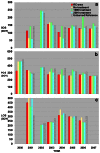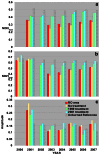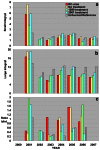Monitoring the Effects of Forest Restoration Treatments on Post-Fire Vegetation Recovery with MODIS Multitemporal Data
- PMID: 27879809
- PMCID: PMC3663040
- DOI: 10.3390/s8032017
Monitoring the Effects of Forest Restoration Treatments on Post-Fire Vegetation Recovery with MODIS Multitemporal Data
Abstract
This study examines how satellite based time-series vegetation greenness data and phenological measurements can be used to monitor and quantify vegetation recovery after wildfire disturbances and examine how pre-fire fuel reduction restoration treatments impact fire severity and impact vegetation recovery trajectories. Pairs of wildfire affected sites and a nearby unburned reference site were chosen to measure the post-disturbance recovery in relation to climate variation. All site pairs were chosen in forested uplands in Arizona and were restricted to the area of the Rodeo-Chediski fire that occurred in 2002. Fuel reduction treatments were performed in 1999 and 2001. The inter-annual and seasonal vegetation dynamics before, during, and after wildfire events can be monitored using a time series of biweekly composited MODIS NDVI (Moderate Resolution Imaging Spectroradiometer - Normalized Difference Vegetation Index) data. Time series analysis methods included difference metrics, smoothing filters, and fitting functions that were applied to extract seasonal and inter-annual change and phenological metrics from the NDVI time series data from 2000 to 2007. Pre- and post-fire Landsat data were used to compute the Normalized Burn Ratio (NBR) and examine burn severity at the selected sites. The phenological metrics (pheno-metrics) included the timing and greenness (i.e. NDVI) for the start, peak and end of the growing season as well as proxy measures for the rate of green-up and senescence and the annual vegetation productivity. Pre-fire fuel reduction treatments resulted in lower fire severity, which reduced annual productivity much less than untreated areas within the Rodeo-Chediski fire perimeter. The seasonal metrics were shown to be useful for estimating the rate of post-fire disturbance recovery and the timing of phenological greenness phases. The use of satellite time series NDVI data and derived pheno-metrics show potential for tracking vegetation cover dynamics and successional changes in response to drought, wildfire disturbances, and forest restoration treatments in fire-suppressed forests.
Keywords: LANDSAT.; MODIS; fire severity; fuel reduction treatments; phenology; vegetation recovery.
Figures
















References
-
- Westerling A. L., Hidalgo H. G., Cayan D. R., Swetnam T. W. Warming and earlier spring increase western US forest wildfire activity. Science. 2006;313:940–943. - PubMed
-
- Finney M.A., McHugh C.W., Grenfell I.C. Stand- and landscape-level effects of prescribed burning on two Arizona wildfires. Canadian Journal of Forest Research-Revue Canadienne de Recherche Forestiere. 2005;35:1714–1722.
-
- Idris M.H., Kuraji K., Suzuki M. Evaluating vegetation recovery following large-scale forest fires in Borneo and northeastern China using multi-temporal NOAA/AVHRR images. Journal of Forest Research. 2005;10:101–111.
-
- Goetz S.J., Fiske G.J., Bunn A.G. Using satellite time-series data sets to analyze fire disturbance and forest recovery across Canada. Remote Sensing of Environment. 2006;101:352–365.
-
- Lin W.-T., Chou W.-C., Lin C.-Y., Huang P.-H., Tsai J.-S. Vegetation recovery monitoring and assessment at landslides caused by earthquake in Central Taiwan. Forest Ecology and Management. 2005;210:55–66.
LinkOut - more resources
Full Text Sources

